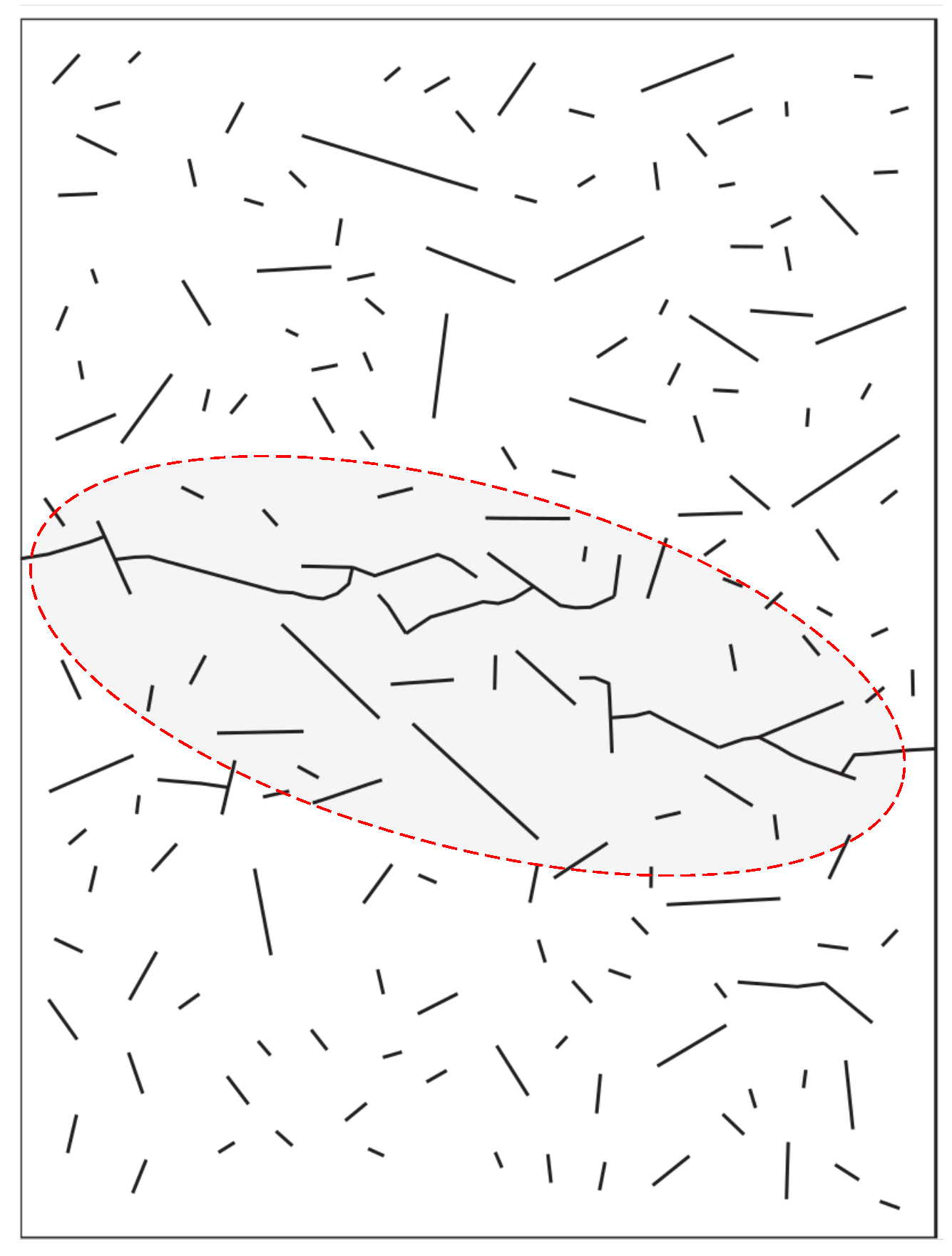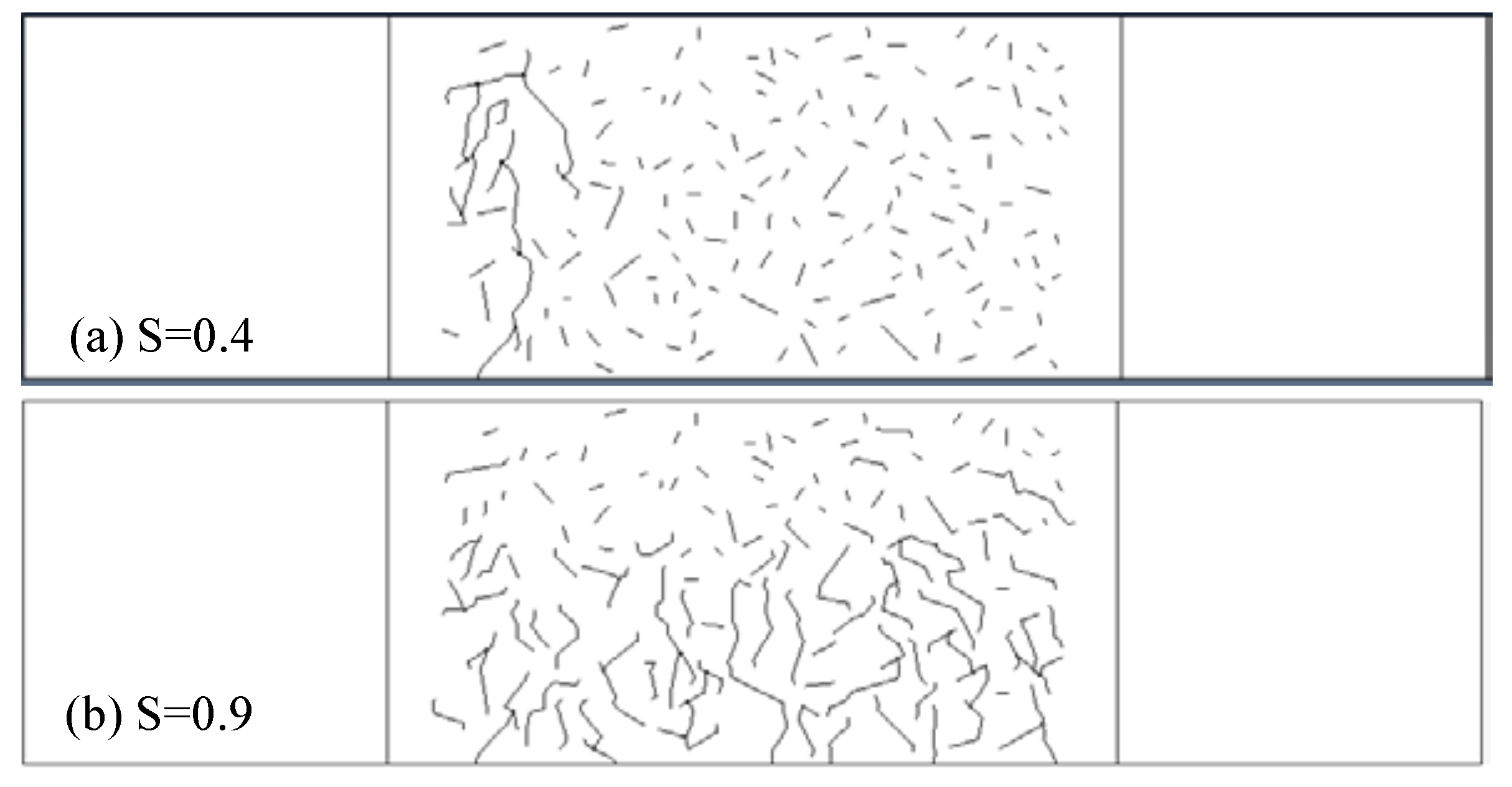Microscopic Multiple Fatigue Crack Simulation and Macroscopic Damage Evolution of Concrete Beam
Abstract
:1. Introduction
2. Microscopic Multiple Crack Simulation and Fatigue Crack Growth Law
2.1. Modeling of Multiple Crack Growth
2.2. Fatigue Crack Growth Law
- In the low rate zone (Stage I) , the crack is set not to propagate because the rate is very low. The fatigue threshold is chosen as
- In the high rate zone (Stage III) , the crack will quickly propagate in an unstable fashion, finally lead to rupture. For the convenience of numerical simulation, here in this zone, the growth rate is practically set to be . Also, the 2nd fatigue threshold is set to be
3. Fatigue Modeling of Three-Point Bending Beams
3.1. Three-Point Bending Beam Model
3.2. Case Design
3.3. Fatigue Failure Analysis
3.4. Influence of Stress Level on Fatigue Behaviors
4. Fatigue Damage Analysis of Concrete Beams
4.1. Fatigue Life and S-N Curve
4.2. Macroscopic Damage Analysis
5. Conclusions
Author Contributions
Funding
Conflicts of Interest
References
- Ovuoba, B.; Prinz, G.S. Investigation of residual fatigue life in shear studs of existing composite bridge girders following decades of traffic loading. Eng. Struct. 2018, 161, 134–145. [Google Scholar] [CrossRef]
- Dias, I.F.; Oliver, J.; Lemos, J.V.; Lloberas-Valls, O. Modeling tensile crack propagation in concrete gravity dams via crack-path-field and strain injection techniques. Eng. Fract. Mech. 2016, 154, 288–310. [Google Scholar] [CrossRef] [Green Version]
- Sun, Z.H.; Scherer, G.W. Effect of air voids on salt scaling and internal freezing. Cem. Concr. Res. 2010, 40, 260–270. [Google Scholar] [CrossRef]
- D’Amato, M.; Laterza, M.; Casamassima, V.M. Seismic performance evaluation of a multi-span existing masonry arch bridge. Open Civ. Eng. J. 2017, 11, 1191–1207. [Google Scholar] [CrossRef]
- Laterza, M.; D’Amato, M.; Braga, F.; Gigliotti, R. Extension to rectangular section of an analytical model for concrete confined by steel stirrups and/or FRP jackets. Compos. Struct. 2017, 176, 910–922. [Google Scholar] [CrossRef]
- Mander, J.B.; Priestley, M.J.N.; Park, R. Theoretical Stress-Strain Model for Confined Concrete. J. Struct. Eng.-ASCE 1988, 114, 1804–1826. [Google Scholar] [CrossRef]
- Khalilpour, S.; BaniAsad, E.; Dehestani, M. A review on concrete fracture energy and effective parameters. Cem. Concr. Res. 2019, 120, 294–321. [Google Scholar] [CrossRef]
- Ding, Z.D.; Li, J. A physically motivated model for fatigue damage of concrete. Int. J. Damage Mech. 2018, 27, 1192–1212. [Google Scholar] [CrossRef]
- Feng, D.C.; Ren, X.D.; Li, J. Stochastic damage hysteretic model for concrete based on micromechanical approach. Int. J. Non-Linear Mech. 2016, 83, 15–25. [Google Scholar] [CrossRef]
- Mai, S.H.; Le-Corre, F.; Foret, G.; Nedjar, B. A continuum damage modeling of quasi-static fatigue strength of plain concrete. Int. J. Fatigue 2012, 37, 79–85. [Google Scholar] [CrossRef] [Green Version]
- Ray, S.; Kishen, J.M.C. Fatigue crack growth due to overloads in plain concrete using scaling laws. Sadhana-Acad. Proc. Eng. Sci. 2012, 37, 107–124. [Google Scholar] [CrossRef]
- Simon, K.M.; Kishen, J.M.C. A multiscale approach for modeling fatigue crack growth in concrete. Int. J. Fatigue 2017, 98, 1–13. [Google Scholar] [CrossRef]
- Papa, E.; Taliercio, A. Anisotropic damage model for the multiaxial static and fatigue behaviour of plain concrete. Eng. Fract. Mech. 1996, 55, 163–179. [Google Scholar] [CrossRef]
- Rezazadeh, M.; Carvelli, V. A damage model for high-cycle fatigue behavior of bond between FRP bar and concrete. Int. J. Fatigue 2018, 111, 101–111. [Google Scholar] [CrossRef]
- Fan, Z.; Sun, Y. Detecting and evaluation of fatigue damage in concrete with industrial computed tomography technology. Constr. Build. Mater. 2019, 223, 794–805. [Google Scholar] [CrossRef]
- Baktheer, A.; Hegger, J.; Chudoba, R. Enhanced assessment rule for concrete fatigue under compression considering the nonlinear effect of loading sequence. Int. J. Fatigue 2019, 126, 130–142. [Google Scholar] [CrossRef]
- Keerthana, K.; Kishen, J.M.C. An experimental and analytical study on fatigue damage in concrete under variable amplitude loading. Int. J. Fatigue 2018, 111, 278–288. [Google Scholar] [CrossRef]
- Ding, Z.D.; Feng, D.C.; Ren, X.D.; Wang, J.F. Physically based constitutive modeling of concrete fatigue and practical numerical method for cyclic loading simulation. Eng. Fail. Anal. 2019, 101, 230–242. [Google Scholar] [CrossRef]
- Maragoni, L.; Carraro, P.A.; Peron, M.; Quaresimin, M. Fatigue behaviour of glass/epoxy laminates in the presence of voids. Int. J. Fatigue 2017, 95, 18–28. [Google Scholar] [CrossRef]
- Sisodia, S.M.; Gamstedt, E.K.; Edgren, F.; Varna, J. Effects of voids on quasi-static and tension fatigue behaviour of carbon-fibre composite laminates. J. Compos. Mater. 2015, 49, 2137–2148. [Google Scholar] [CrossRef]
- Malekan, M.; Carvalho, H. Analysis of a main fatigue crack interaction with multiple micro-cracks/voids in a compact tension specimen repaired by stop-hole technique. J. Strain Anal. Eng. Des. 2018, 53, 648–662. [Google Scholar] [CrossRef]
- Bazant, Z.P.; Xu, K.M. Size Effect in Fatigue Fracture of Concrete. ACI Mater. J. 1991, 88, 390–399. [Google Scholar]
- Bazant, Z.P.; Schell, W.F. Fatigue Fracture of High-Strength Concrete and Size Effect. ACI Mater. J. 1993, 90, 472–478. [Google Scholar]
- Paggi, M. Modelling fatigue in quasi-brittle materials with incomplete self-similarity concepts. Mater. Struct. 2011, 44, 659–670. [Google Scholar] [CrossRef]
- Bhowmik, S.; Ray, S. An improved crack propagation model for plain concrete under fatigue loading. Eng. Fract. Mech. 2018, 191, 365–382. [Google Scholar] [CrossRef]
- Roe, K.L.; Siegmund, T. An irreversible cohesive zone model for interface fatigue crack growth simulation. Eng. Fract. Mech. 2003, 70, 209–232. [Google Scholar] [CrossRef]
- Del Busto, S.; Betegon, C.; Martinez-Paneda, E. A cohesive zone framework for environmentally assisted fatigue. Eng. Fract. Mech. 2017, 185, 210–226. [Google Scholar] [CrossRef] [Green Version]
- Kirane, K.; Bazant, Z.P. Microplane damage model for fatigue of quasibrittle materials: Sub-critical crack growth, lifetime and residual strength. Int. J. Fatigue 2015, 70, 93–105. [Google Scholar] [CrossRef]
- Nguyen, N.H.T.; Bui, H.H.; Kodikara, J.; Arooran, S.; Darve, F. A discrete element modeling approach for fatigue damage growth in cemented materials. Int. J. Plast. 2019, 112, 68–88. [Google Scholar] [CrossRef]
- Wang, Y.P. Physical stochastic damage model for concrete subjected to fatigue loading. Int. J. Fatigue 2019, 121, 191–196. [Google Scholar] [CrossRef]
- Wu, B.; Tang, K. Modelling on crack propagation behaviours at concrete matrix-aggregate interface. Fatigue Fract. Eng. Mater. Struct. 2019, 42, 1803–1814. [Google Scholar] [CrossRef]
- Wu, B.; Li, Z.; Tang, K. Numerical modeling and analysis on micro-to-macro evolution of crack network for concrete materials. 2019; submitted. [Google Scholar]
- Paris, P.; Erdogan, F. A critical analysis of crack propagation laws. J. Basic Eng. 1963, 85, 528–533. [Google Scholar] [CrossRef]
- Lou, J.; Bhalerao, K.; Soboyejo, A.B.O.; Soboyejo, W.O. An investigation of the effects of mix strength on the fracture and fatigue behavior of concrete mortar. J. Mater. Sci. 2006, 41, 6973–6977. [Google Scholar] [CrossRef]
- Chen, C.; Cheng, L.J. Fatigue Behavior and Prediction of NSM CFRP-Strengthened Reinforced Concrete Beams. J. Compos. Constr. 2016, 20. [Google Scholar] [CrossRef]
- Lemaitre, J. A Course on Damage Mechanics; Springer Science & Business Media: Berlin/Heidelberg, Germany, 2010. [Google Scholar]
- Tang, K.K.; Li, Z.X.; Wang, J. Numerical simulation of damage evolution in multi-pass wire drawing process and its applications. Mater. Des. 2011, 32, 3299–3311. [Google Scholar] [CrossRef]
- Tang, K.K.; Li, Z.X.; He, D.D.; Zhang, Z.H. Evolution of plastic damage in welded joint of steel truss with pre-existing defects. Theor. Appl. Fract. Mech. 2010, 54, 117–126. [Google Scholar] [CrossRef]












| No. | S | (N) | () |
|---|---|---|---|
| 1 | 0.9 | 90 | 3 |
| 2 | 0.8 | 80 | 5 |
| 3 | 0.7 | 70 | 10 |
| 4 | 0.6 | 60 | 25 |
| 5 | 0.5 | 50 | 36 |
| 6 | 0.4 | 40 | 42 |
| 7 | 0.3 | 30 | 66 |
| 8 | 0.2 | 20 | 122 |
| 9 | 0.1 | 10 | 201 |
© 2019 by the authors. Licensee MDPI, Basel, Switzerland. This article is an open access article distributed under the terms and conditions of the Creative Commons Attribution (CC BY) license (http://creativecommons.org/licenses/by/4.0/).
Share and Cite
Wu, B.; Li, Z.; Tang, K.; Wang, K. Microscopic Multiple Fatigue Crack Simulation and Macroscopic Damage Evolution of Concrete Beam. Appl. Sci. 2019, 9, 4664. https://doi.org/10.3390/app9214664
Wu B, Li Z, Tang K, Wang K. Microscopic Multiple Fatigue Crack Simulation and Macroscopic Damage Evolution of Concrete Beam. Applied Sciences. 2019; 9(21):4664. https://doi.org/10.3390/app9214664
Chicago/Turabian StyleWu, Baijian, Zhaoxia Li, Keke Tang, and Kang Wang. 2019. "Microscopic Multiple Fatigue Crack Simulation and Macroscopic Damage Evolution of Concrete Beam" Applied Sciences 9, no. 21: 4664. https://doi.org/10.3390/app9214664





